The Bivalves for Clean Water program is no longer an active Washington Sea Grant program. For information go to:
- Bivalves for Clean Water Facebook page
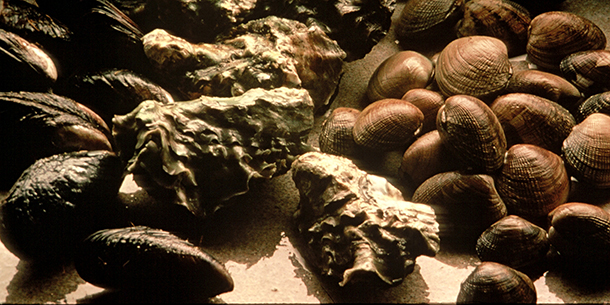
The Bivalves for Clean Water program is no longer an active Washington Sea Grant program. For information go to:
Teri King, Marine Water Quality Specialist
WSG is closely monitoring the outbreak of the novel coronavirus — which causes the disease known as COVID-19 — and is making every possible effort to address the changing needs of the local shellfish aquaculture community. Through community outreach and a webpage, WSG is helping Washington State shellfish industry members connect to resources provided by the Washington State Governor’s office during the COVID-19 outbreak.
See the COVID-19 Resources for Shellfish Industry web page for up to date information.
Melissa Poe, Social Scientist
WSG is leading a three-year grant to advance sustainable Indigenous Aquaculture practices and enhance seafood production in the Pacific region. Working in coordination with Hawaii and Alaska Sea Grants, WSG launched a cross-Pacific regional collaborative effort integrating research, outreach and education funded, in part, through a grant from the National Sea Grant Aquaculture Initiative.
Over 125 guests recently attended the first collaborative summit meeting held on Oahu, including representatives from 13 Pacific Northwest tribes and many more from across the globe. Attendees learned about traditional Hawaiian aquaculture practices and technologies. It was a catalyzing event resulting in a number of new collaborations amongst participants.
Meg Chadsey, Ocean Acidification Specialist
Interest in macroalgae aquaculture is growing. Kelp and other seaweeds can be grown for food, animal feed, organic fertilizer, biofuels and other sustainable products. In Washington State, kelp aquaculture grew out of ocean acidification (OA) research. Because macroalgae absorbs nutrients and carbon dioxide as it grows, co-cultivation of macroalgae alongside farmed marine species can help recycle waste, and may buffer vulnerable organisms from the corrosive effects of OA.
WSG works with partners to investigate the impact that kelp aquaculture can have on OA and the potential commercial markets for farmed kelp, including using kelp as food and as fertilizer
In 2019, WSG lead a 3-day training for potential kelp farmers, created a go-to website for providing basic information for getting started all in one place, and continues to field inquiries from around the state.
WSG staff can also help answer questions about kelp and seaweed aquaculture and the educational and funding resources that are currently available.
Teri King, Marine Water Quality Specialist
Each year, WSG participates in and organizes conferences and training workshops on aquaculture and related issues and shares research findings with decision makers, producers and resource managers.
WSG contributes to the Washington State Shellfish Initiative, the annual Shellfish Growers Conference, the Pacific Rim Shellfish Sanitation Conference, and one-time events such as symposia on aquaculture and the environment.
For current and upcoming events or webinars, check the Events Calendar.
Email Teri King at wsgcanal@uw.edu
Teri King, Marine Water Quality Specialist
Shellfish need clean water to thrive. Pollutants can destroy their beds, and bacteria taken up by shellfish can sicken people who eat them. WSG’s State of the Oyster Study is a citizen science monitoring program that trains waterfront property owners to test the safety of their shellfish before consumption. Four times a year, residents gather clams and oysters at low tide and bring them to WSG to be tested for Vibrio parahaemolyticus and bacterial indicators of fecal contamination. WSG then helps participants interpret the test results and, if necessary, works closely with them to identify and remedy sources of contamination.
The WSG Well Education and Testing program (WET)
WET is offered in tandem with the State of the Oyster Study. Testing your well water is the best way to identify possible contamination. The WSG WET provides homeowners with a local, inexpensive way to test well water.
December 6, 2023
After working at Washington Sea Grant (WSG) for more than 30 years, Teri King, aquaculture and marine water quality specialist, has moved on to her next chapter.
King joined WSG in 1990. Over the next three decades, she built an innovative program of outreach and technical assistance around the issues of shellfish aquaculture and Puget Sound water quality, reaching thousands who shared her passion for healthy marine waters and resources. Her program has helped to develop aquaculture best practices, enhance shellfish resources, monitor marine waters, reduce pollution, and protect coastal environmental health, all while building a strong foundation of longstanding partnerships around the region.
King’s many contributions to WSG, the University of Washington, and broader aquaculture communities during her tenure have been impactful. Among her accomplishments, she developed the “Septic Sense” program to help homeowners reduce pollution into Puget Sound; managed SoundToxins, a diverse partnership of aquaculture businesses, environmental learning centers, tribes and volunteers working together to minimize the impacts of harmful algal blooms; provided technical assistance to hundreds of aquaculture farms and businesses; created the State of the Oyster Study to train waterfront property owners to test the safety of their shellfish; developed training programs for proper seafood handling; organized the annual Conference for Shellfish Growers; and conducted groundbreaking research published in science publications. .
The impact of King’s work is deeply felt in Washington and beyond. She organized more than 1,000 outreach events for children and adults, from beach walks and cleanups to workshops on low-impact gardening, home septic systems, and shellfish monitoring. In 2012, the state was able to open Lynch Cove to shellfish harvesting for the first time in 25 years, a demonstration of King’s work with residents through the State of the Oyster Study and other programs. In 2013, the Jamestown S’Klallam Tribe’s SoundToxin team identified rising levels of Dinophysis, which causes diarrhetic shellfish poisoning. The team alerted NOAA and the Washington Department of Health, triggering enhanced shellfish tissue sampling and likely preventing illnesses. King’s timely assistance to a family-owned shellfish farm once prevented the loss of 300,000 oysters from summer mortality. These and other successes point to King’s special ability to not only act on scientific information, but also to make it understandable and accessible to others.
Though King has left WSG, she remains active in Washington’s aquaculture scene. She is now working as the Washington and Oregon Regional Aquaculture Coordinator for NOAA’s West Coast Regional Office. “My new position will allow me to continue working with WSG and the aquaculture community, and also grow professionally,” King says.
WSG is grateful for the legacy that Teri built in serving Washington’s coastal communities. WSG will be working over the coming months to fill the vacancy left by her departure and looks forward to continuing many of the programs she started. The SoundToxins program is now under the leadership of WSG marine water quality specialist Michelle Lepori-Bui. Stay tuned for more information about the Conference for Shellfish Growers scheduled for March 2024.
###
Washington Sea Grant, based at the University of Washington, helps people and marine life thrive through research, technical expertise and education supporting the responsible use and conservation of coastal ecosystems. The National Sea Grant College Program is part of the National Oceanic and Atmospheric Administration, U.S. Department of Commerce.
Join the conversation: instagram.com/waseagrant and Facebook.com/WaSeaGrant.
December 5, 2023
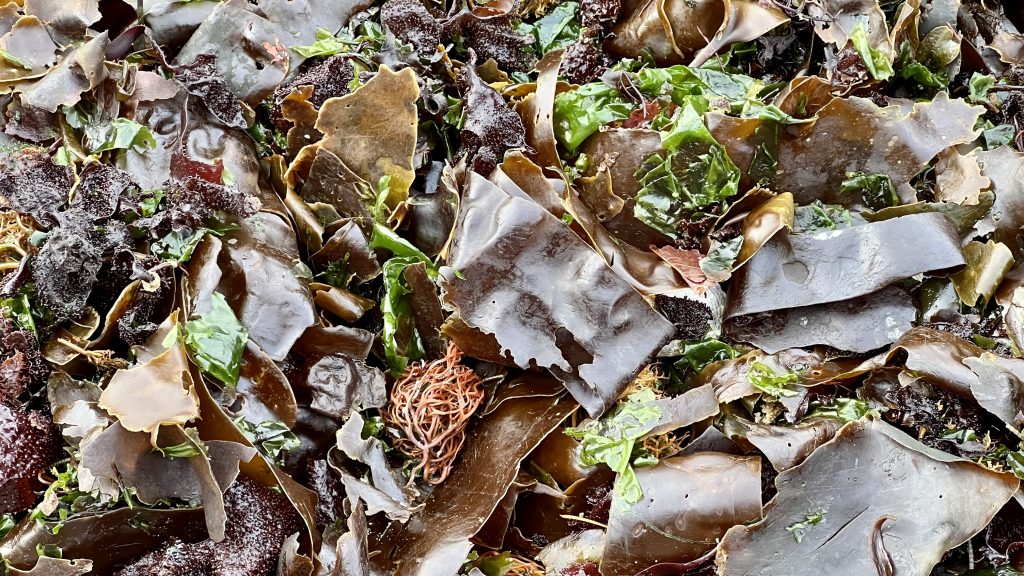
The seaweed of Puget Sound. Photo credit: Simone Alin
Seaweed aquaculture in Washington is a bit like the “Cheshire cat”: though there are a handful of commercial farms and restoration projects, a few pending permits, and a whole lot of enthusiasm, it’s mostly not there…yet. Whether seaweed farming will truly take off in this state, and how, is an open question. But amidst this uncertainty lies opportunity.
The foundation being laid for seaweed farming and restoration efforts today may set precedents for years to come. Given the unknowns — and the stakes — maintaining communication and collaboration among everyone involved in the burgeoning seaweed space is imperative. “We’re trying to foster a culture of cooperation and adaptive management,” said Meg Chadsey, carbon specialist at Washington Sea Grant (WSG). “We need to be able to try new things, learn from them, and be open to changing course.” Chadsey had these ideas in mind when she organized Washington’s first ever Seaweed Knowledge Symposium in December 2022 in Lacey, Washington. (Video recordings of the event are available on WSG’s YouTube channel).
The Symposium addressed four key goals: developing a deeper understanding of the local seaweed community’s interests and concerns; equipping that community to make responsible decisions around seaweed farming; understanding the gaps between the current state of knowledge and aspirations and goals for seaweed farming; and inspiring participants to work together to address information gaps and policy questions. “One of the main goals of the Symposium was to increase communication and connection within the seaweed community,” said Nicole Naar, social science and education specialist at WSG, who helped plan the event.
Speakers at the Symposium represented a broad range of expertise and experience, from the uptake of contaminants by seaweed to restoring declining wild kelp forests to the limitations of growing seaweed to sequester carbon. The perspectives of local Indigenous community members were also sought out and emphasized. Tela Troge, a member of the Shinnecock Nation in New York, offered her perspective on farming seaweed to assert tribal sovereignty, particularly as urban development and greenhouse gas emissions threaten traditional practices. “I think of ways I can protect the water so my son can engage in fishing rights for years to come,” said Troge. “My answer was seaweed farming.”
Many Indigenous people in the Pacific Northwest similarly see farming seaweed as a way to reclaim aspects of their culture. “In the past, seaweeds were always part of our everyday life,” said Loni Grinnell-Greninger (“yúčciʔə”), Tribal Council Vice Chair of the Jamestown S’Klallam Tribe. “When treaties were signed and settlers were moving in and we were removed from our land, some of our relationships with kelp and seaweed broke. So now we’re getting reacquainted.” Grinnell-Greninger and others spoke to the importance of non-tribal seaweed growers understanding this history and the position of treaty tribes in Washington as co-managers of marine resources. “I would ask any prospective seaweed farmer to acknowledge that your farm may be on ancestral territory of a Tribe,” she said. “I would ask any farmer to think about that, and to farm with good intentions. I would also encourage that farmer to think about partnering with a local Tribe.”
Helping to heal the environment is often cited as a primary motivation for aspiring seaweed farmers. Speakers at the Symposium covered the potential of growing seaweed to provide habitat to salmon and other animals, as well as absorb the excess carbon dioxide that’s causing ocean acidification. As efforts to restore wild kelp beds ramp up in Washington, there’s increasing opportunity for interplay between seaweed farming and seaweed restoration. Lee-Ann Ennis, who cultivates kelp on the Sunshine Coast in British Columbia, began farming native seaweeds to provide fish habitat, and now sees forage fish spawning on her kelp. “There is a lot of overlap between kelp farming, research and restoration,” Ennis said.
For others, seaweed farming simply represents a relatively less-impactful method of producing food. “From a planetary perspective, we’re more than 8 billion people,” said Joth Davis, a scientist and founder of Blue Dot Sea Farms. “We need to address the food supply — and that’s going to include using the ocean in ever-increasing ways.”
“Puget Sound needs a lot of help,” said Meg Chadsey, who also coordinates the Washington Seaweed Collaborative. “We can’t afford to ignore potential solutions. In the years to come, I predict we’ll be trying a lot of things we’ve never done before.”
###
Washington Sea Grant, based at the University of Washington, helps people and marine life thrive through research, technical expertise and education supporting the responsible use and conservation of coastal ecosystems. The National Sea Grant College Program is part of the National Oceanic and Atmospheric Administration, U.S. Department of Commerce.
www.wsg.uw.edu.
Join the conversation: instagram.com/waseagrant and Facebook.com/WaSeaGrant.
December 12, 2023
Subject to the availability of funding, Sea Grant anticipates $5,000,000 to $6,000,000 will be available for research projects and programs that will develop and refine methods, protocols, techniques, and/or strategies to enhance the production of one or more life stages of aquaculture species with the overall goal of improving the efficiency, output, and profitability of commercial coastal, marine, or Great Lakes region aquaculture businesses.
Total funding for this competition includes approximately $5,000,000-$6,000,000 to support 4-12 projects for up to three years:
Applications require the standard 50% non-federal match for Sea Grant projects.
Federal Funding Opportunity: NOAA-OAR-SG-2024-24677
Please carefully review the Notice of Funding Opportunity (NOFO) for specific instructions on how to apply for the competition via grants.gov.
Proposal Deadlines:
Letters of Intent are due January 17, 2024
Full applications to this competition must be submitted to Grants.gov by 11:59 pm Eastern Time on April 3, 2024.
Please contact oar.hq.sg.aquaculture@noaa.gov with any questions regarding this NOFO and please specify the opportunity in the subject line.
###
Washington Sea Grant, based at the University of Washington, helps people and marine life thrive through research, technical expertise and education supporting the responsible use and conservation of coastal ecosystems. The National Sea Grant College Program is part of the National Oceanic and Atmospheric Administration, U.S. Department of Commerce.
Join the conversation: instagram.com/waseagrant and Facebook.com/WaSeaGrant.
Contact: coastshellfishstudy@uw.edu
Working with Southwest Washington shellfish growers, WSG is leading a three-year, multi-partner, applied research project to assist planning and collaboration amongst tideland managers, owners and regulators in the coastal communities of Willapa Bay and Grays Harbor, Washington. The study aims to sustain shellfish aquaculture in the two bays by establishing a collaborative ecosystem-based management framework to identify solutions to current challenges, such as ghost shrimp overpopulation, and to provide support for ongoing participation from tideland managers, owners and regulators.
To date, the WSG team leading this effort has successfully created for the first time a “working advisory group” comprised of stakeholders and completed a 2-day workshop to be followed by an online workshop this spring. Other outcomes include a literature review summarizing key ecological interactions and identifying knowledge gaps in coastal Washington’s shellfish aquaculture industry; a series of public workshops highlighting these knowledge gaps
February 20, 2024
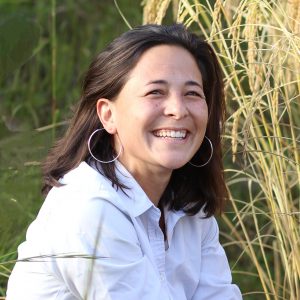
Washington Sea Grant (WSG) is excited to welcome Jessika Tantisook as its first Economic Recovery Corps fellow. The inaugural cohort of the Economic Recovery Corps (ERC) will spend the next 2.5 years enhancing the economic development efforts of host organizations like WSG around the United States.
Jessika’s work, in particular, will cover several focus areas on the southwest Washington coast. Long reliant on ocean-based livelihoods like fishing, boating, and the industries they support, these communities face growing challenges, from changing weather patterns to an aging marine workforce. Amidst these complexities, the Coastal Opportunities for Resilience and Livelihoods (CORaL) project honors the desire of Washington’s rural coastal communities to maintain a strong marine-based economy. Initiatives under the CORaL project include the creation of a new business incubator and marine trade center; increased marine trade training efforts; marine economic visioning; and the development of tribal shellfish aquaculture. Jessika will be responsible for stakeholder engagement and facilitating communication across partners and regions, helping to create a comprehensive vision of a resilient and robust ocean economy across the Washington coast.
Jessika has lived and worked in economic development on Washington’s coast for over a decade. As a coastal community leader and local food systems aficionado, she has experience starting and operating an organic food processing business, building a regional food hub, and developing equity-focused programming to support small businesses. Most recently, she spent five years as the Executive Director of the nonprofit North Coast Food Web, leading the creation of its first strategic plan and helping to grow its food hub operations into a pillar of the Columbia-Pacific region’s local food economy.
“As a decade-long coastal community member, I’m looking forward to adding much needed capacity to key projects in our region,” Jessika notes. “I’m excited to meet and learn from the Washington Sea Grant team, and to share all the great things we’re doing locally with my national cohort of fellows.”
The ERC Fellowship program aims to build capacity in economically distressed areas across the U.S. while cultivating the next generation of economic development leaders. The program connects 65 host sites nationwide with diverse practitioners and leaders with the passion, skills, and vision to create new ways of doing economic development. The ERC Fellowship was launched in 2023 through a $30 million cooperative agreement with the U.S. Department of Commerce’s Economic Development Administration. It is led by the International Economic Development Council and supported by 6 other national economic development organizations.
Learn more about the ERC here, and about Jessika’s project here.
###
Washington Sea Grant, based at the University of Washington, helps people and marine life thrive through research, technical expertise and education supporting the responsible use and conservation of coastal ecosystems. The National Sea Grant College Program is part of the National Oceanic and Atmospheric Administration, U.S. Department of Commerce.
Join the conversation: instagram.com/waseagrant and Facebook.com/WaSeaGrant.
June 27, 2024
By Alison Lorenz, WSG Science Writer
To friends and family, Nick Mendoza has always been “the fish guy.” From what he describes as an “uncanny obsession” with fish in his youth to his work as a marine scientist, a love of the ocean is as inherent to Mendoza as his entrepreneurial spirit. Perhaps these traits explain why, amid constant texts from loved ones asking how to eat more, and more sustainable, seafood, Mendoza saw not a challenge, but an opportunity.
Mendoza grew up in New Mexico and attended college in California. After getting a degree in aquaculture, he jumped right into the field, working in next generation aquafeed sustainability related to farming yellowtail and bluefin tuna and in a lab studying shrimp reproduction. He lived the picturesque life of a marine scientist, sailing on Pacific research expeditions, tagging tuna and even great white sharks. But though he was passionate about the ocean and sustainability, something didn’t feel right. Over time, he saw how infrequently insights from his research projects were actually put into practice.
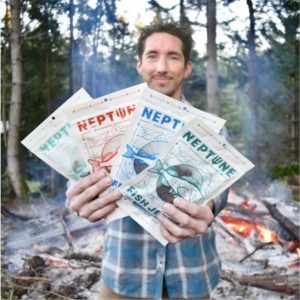
Mendoza and his company’s fish jerky. Photo courtesy of Nick Mendoza.
“Big problems exist in the global seafood industry that need change and are ripe for change,” Mendoza explains. After becoming disillusioned with the incremental impacts he was making as a marine scientist, he decided to switch tracks: “The path for creating that change is consumers who are looking for the thing that can drive it.”
Mendoza left his career as a marine biologist and moved home to New Mexico to plan his next steps. For his burgeoning business idea, he took inspiration from his family’s cattle ranch. At the time, the ranch was exploring the idea of farm-to-table beef – a concept that Mendoza thought could also apply to fish. “Seafood could be a vector for a message,” he remembers thinking. “For these tenants that I tell people in my daily life – that there needs to be science at the source, traceability, all these pieces that contribute to regenerative seafood systems.” Those ideas took shape into the brand, and product, of Mendoza’s newly formed company, Neptune Snacks.
As Mendoza learned, global seafood supply chains can be tricky to navigate. Most seafood eaten in the US is imported; at the same time, the US exports most of its domestic catch. A lack of traceability means that problems like seafood fraud – where seafood is mislabeled as another species, or as having a different country of origin – is common. Neptune Snacks sells fish jerky made from “imperfect” cuts of fish: the cuts are too small or the wrong size to sell in grocery stores or restaurants, but are otherwise high quality. The fish themselves are wild-caught from two healthy domestic fisheries, Alaska pollock and Pacific rockfish. In not only reclaiming fish that would otherwise be wasted, but also sourcing it from robust local populations, Mendoza’s company aims to model a new kind of seafood supply chain, where traceability is the basis of sustainability. Each package of jerky even includes a QR code customers can use to trace the fish back to the vessel on which it was caught.
Seafood snack companies have a unique role to play in educating consumers about seafood and sustainability. “We have the opportunity to be storytellers right in hand with the consumer, because our product and existence is entirely consumer-centric,” Mendoza explains. Neptune Snacks uses all kinds of marketing to connect with customers, from its social media platforms to in-person store demos and presence at festivals like Ballard Seafood Fest in Seattle, where the company is headquartered. “It’s a pretty cool, rare opportunity to be spending a big portion of our time on awareness and telling the very story of what makes the fishermen and fisheries and US wild-caught seafood so special.”
The goal is to make it as simple as possible for people to “find two or three local and sustainable seafood items that they really like,” Mendoza says. The more people can form connections with tasty local seafood, the more they’ll choose it in the future – and help to build local economies that sustain US fishing communities and better value healthy, sustainable seafood produced close to home.
“I’ve been delighted to discover that if you build it they will come,” Mendoza says of his business journey. “There are so many people who post videos about their experience trying something, or send a watercolor painting of our package that their kindergartner did. You’ve created something that ends up in their stomachs and households.”
###
Washington Sea Grant, based at the University of Washington, helps people and marine life thrive through research, technical expertise and education supporting the responsible use and conservation of coastal ecosystems. The National Sea Grant College Program is part of the National Oceanic and Atmospheric Administration, U.S. Department of Commerce.
Join the conversation: instagram.com/waseagrant and Facebook.com/WaSeaGrant.
June 3, 2024
By Alison Lorenz, WSG Science Writer
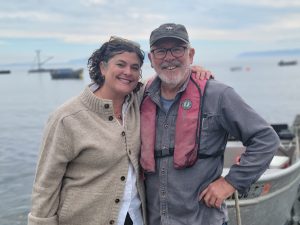
Riley Starks with chef and restauranteur Renee Erickson. Photo courtesy of Riley Starks.
Riley Starks had never fished a day in his life and had rarely been on the water when he graduated college in 1972. But he had a whole year ahead of him before he started law school, he needed money, and a friend of his had just bought a boat. When his friend asked Riley to come crew with him that winter, Riley did. “And it was just one of those moments when you have an epiphany,” Starks says. He came back after a winter of crab fishing, sold everything, and bought a boat of his own.
The start of Starks’s long career in fishing had its rough waters. His whole family came down to watch him take possession of his new boat at Ebey Slough, a narrow inlet near Everett. Nervous and unsure of how to turn around, Starks backed his new boat all the way out to sea. When he finally tied up at his destination, he was “so freaked out” he didn’t return for a week. Seven days later, the boat was nearly sunk, water from a leaky shaft log rising almost to the engine’s spark plugs. A nearby fisherman pulled up and offered him a #10 can to bail water out. “He pulled away laughing at me,” Starks says.
But rough waters and all, things fell into a rhythm. Starks was able to make a deal with a canning company early on, giving him a steady income. In addition to fishing Dungeness crab in the winter, he gillnetted for salmon out of the Fraser River in the summer. He tried out herring fishing in San Francisco and eventually got a coveted permit to fish salmon in Bristol Bay, Alaska, which he did for the next 20 years. Though there were bumps along the way – a night they forgot to anchor in San Francisco, a sinking in Bristol Bay (no one was hurt) – Starks did well fishing. “It’s a pattern,” he says. “I did things without really being trained, without knowing – and when doing that, you make mistakes.” But in his case, Starks also learned a lot.
Starks now focuses on a sustainable type of fishing called reefnetting. First developed by the Coast Salish people nearly two millennia ago, reefnet fishing involves anchoring two 40 foot barges to an artificial reef that acts as a funnel, leading the salmon up and over a square net suspended between the barges. A fisher stands on a tall tower or watches through a camera to see when salmon swim over the net. Then, solar-powered electric winches pull up the net while the crew spills fish into the live well. In the live well the salmon rest, swimming into the current and losing any lactic acid buildup in their muscles, until they are hand-sorted. Any unwanted catch is released back into the water unharmed, while the targeted species is bled as it swims.
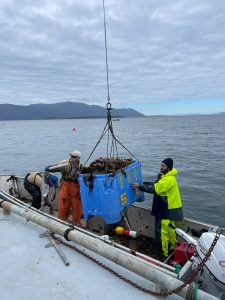
Harvesting kelp with Lummi Island SeaGreens. Photo courtesy of Meg Chadsey.
The sustainability of reefnetting led Starks to found the Salish Center, one of whose goals is to make reefnet fishing “the primary method for harvesting salmon in the Salish Sea.” The Center promotes reefnetting and the Salish Sea with communities in any way it can. In addition to dinners, festivals, reefnet fishing and seaweed excursions, the Center runs Wave Warrior, Adopt an Orca, and Salish Sea Certified programs – all with the goal of fostering the same love for the Salish Sea that Starks himself radiates.
Then there’s the Center’s newest venture, Lummi Island SeaGreens. One of the first commercial seaweed farms in Washington, SeaGreens fits neatly into the Center’s mission to encourage restoration and stewardship of the Salish Sea. Seaweed provides habitat for a variety of marine life in addition to improving water quality. When his business partner and Salish Center Board President Larry Mellum suggested they get into seaweed, Starks’s first thought was that he didn’t need another project – “but here I am, doing the work,” he says. “It’s exciting, but also challenging to be on the spearhead of it.” To this writer, it seems to fit the pattern of Starks’s life: the willingness to try something new, again and again. And with the Salish Center, Starks has a strong purpose in mind.
The Salish Sea is a uniquely vibrant ecosystem rich with marine life like kelp, salmon and orcas. At the same time, the threats facing the Sea are significant, from overfishing – Starks’s focus – to polluted runoff and habitat destruction. “People need hope,” Starks says of the reason behind the Center’s many projects. “Once they learn about the Salish Sea, it’s life changing. They really care and want to do something.”
“I was born to fish and I didn’t know it,” Starks says. “[Now] I’ve fished these waters for more than 50 years, and I’ve seen the changes. There’s a lot of good news.”
###
Washington Sea Grant, based at the University of Washington, helps people and marine life thrive through research, technical expertise and education supporting the responsible use and conservation of coastal ecosystems. The National Sea Grant College Program is part of the National Oceanic and Atmospheric Administration, U.S. Department of Commerce.
Join the conversation: instagram.com/waseagrant and Facebook.com/WaSeaGrant.
Teri King, Marine Water Quality Specialist
This video documentary about Willapa Bay by Washington native Keith A. Cox captures the oystering livelihood and lifestyle that endure on Willapa Bay, southwest Washington, and define its spirit and tradition.
WSG supported the project and staff are working with the producer on hosting future film showings and an interactive display to accompany the film.